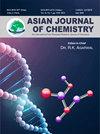Recent Developments in the Extraction of Lithium from Water Resources
Q4 Chemistry
引用次数: 4
Abstract
An increasing number of electric vehicles, hybrids, and synergistic types are adding electronic components, driving up demand for lithium and its derivatives. These chemicals comprise 80% of the worldwide market and come in forms such as carbonate, lithium hydroxide and mineral concentrates. The use of lithium is predicted to surge by 60% in the coming years due to the proliferation of electric vehicles. This demands efficient and rapid deposit detection methods as well as economical and high-resolution exploration equipment. The quantity and geographical distribution of fossil and ore mineral deposits can be easily mapped using hyperspectral photography. Since salt lakes, oceans, and geothermal water hold the majority of the world’s lithium reserves ranging from 70% to 80%, these areas are ideal for the lithium extraction process. In this regard, there is an increase in research targeted at industrial lithium production from water resources. Recycling lithium-ion batteries is an alternative method that can be utilized to increase the production of lithium. Geothermal waters have lower lithium contents than brines and some of the processes are not suitable. Evaporation methods, solvent extraction, membrane technology, nanofiltration and adsorption can all be used to extract lithium from liquid media. Thus, lithium extraction from aqueous solutions was the focus of this review article, which aimed to provide straightforward technical solutions, low costs, decreased environmental impact and excellent selectivity for the lithium industry.从水资源中提取锂的最新进展
越来越多的电动汽车、混合动力汽车和增效型汽车增加了电子元件,从而推动了对锂及其衍生物的需求。这些化学品占全球市场的 80%,有碳酸盐、氢氧化锂和矿物浓缩物等形式。由于电动汽车的普及,预计未来几年锂的使用量将激增 60%。这就需要高效、快速的矿藏探测方法,以及经济、高分辨率的勘探设备。使用高光谱摄影技术可以轻松绘制化石和矿石矿藏的数量和地理分布图。由于盐湖、海洋和地热水拥有全球 70% 至 80% 的大部分锂储量,这些地区是锂提取工艺的理想之地。因此,利用水资源进行工业锂生产的研究也在不断增加。回收锂离子电池是提高锂产量的另一种方法。地热水的锂含量比卤水低,有些工艺并不适合。蒸发法、溶剂萃取、膜技术、纳滤和吸附都可用于从液体介质中提取锂。因此,从水溶液中提取锂是这篇综述文章的重点,旨在为锂工业提供直接的技术解决方案、低成本、减少环境影响和出色的选择性。
本文章由计算机程序翻译,如有差异,请以英文原文为准。
求助全文
约1分钟内获得全文
求助全文
来源期刊

Asian Journal of Chemistry
化学-化学综合
CiteScore
0.80
自引率
0.00%
发文量
229
审稿时长
4 months
期刊介绍:
Information not localized
 求助内容:
求助内容: 应助结果提醒方式:
应助结果提醒方式:


